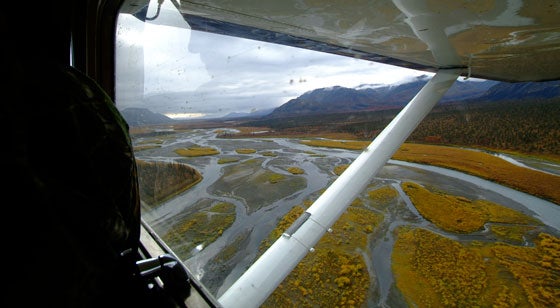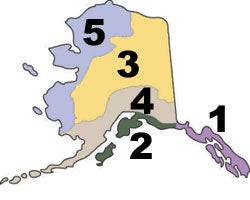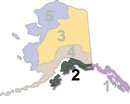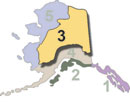Alaska Hunt Planning: The Location
Inexperienced Alaska hunters often make the mistake of thinking that hunt planning is all about location. Nothing could be farther from the truth. Anyone who has stood knee-deep in a river next to a skilled angler who was landing one fish after another while everyone else went home skunked knows that there are four legs to the stool:
- The Right Location
- The Right Skills
- The Right Tools
- The Right Timing
This page is about finding the right location. In a state twice the size of Texas, with 365,000 miles of rivers and a coastline longer than that the entire combined coastline of the Lower 48 states, it's no small task. So you have to digest it the same way you eat the proverbial elephant: one bite at a time.

A Regional Approach
We've taken some of the guesswork out of it by breaking the state down into five regional areas,  each of which presents unique ecosystems, unique terrain and weather patterns, a unique mix of available species and unique hunting conditions. These areas are the same regions used by the Alaska Department of Fish and Game, for game management purposes. Each region contains several Game Management Units (GMU) or portions thereof.
each of which presents unique ecosystems, unique terrain and weather patterns, a unique mix of available species and unique hunting conditions. These areas are the same regions used by the Alaska Department of Fish and Game, for game management purposes. Each region contains several Game Management Units (GMU) or portions thereof.
The Alaska Department of Fish & Game assigns biologists to each of the five regions. These people are tasked with knowing their area and the game populations within it, together with any details pertaining to managing the game populations in support of the "maximum sustained yield" principles laid out by the Alaska legislature. These biologists posess a wealth of information essential to the hunt planning process. For a detailed description of the kind of information you can glean from them, see our Resources page.
For a general orientation to the characteristics of each region of Alaska, visit our main Regions page. This site also has separate pages for each region, which includes details on hunting opportunities in those areas. Here is a list of each region, together with which GMUs or portions are in each region. Click on each Region's title to go to that region's page.
Region 1
Southeast Alaska: GMU 1, 2, 3, 4 & 5
Region 1 South: Southeast Panhandle | Region 1 North: Yakutat / Cordova Area
Available species:
Black Bear | Brown / Grizzly Bear | Deer | Elk | Goat | Moose | Wolf
Region 2
North Gulf Coast, Kenai Peninsula, and the Kodiak / Afognak Archipelago: GMU 6, 7, 8, 14C, 15
Region 2 East: North Gulf Coast / Kenai Peninsula | Region 2 West: Kodiak / Afognak Archipelago
Available species:
Bison | Black Bear | Brown / Grizzly Bear | Caribou | Dall Sheep | Deer | Elk | Goat | Moose | Wolf
Region 3
Interior, Eastern Arctic: GMU 12, 19, 20, 21, 24, 25, 26B, 26C
Region 3 East: Eastern Arctic / Eastern Interior | Region 3 West: Central Interior
Available species:
Bison | Black Bear | Brown / Grizzly Bear | Caribou | Dall Sheep | Moose | Wolf
Region 4
Anchorage Area, Bristol Bay, Alaska Peninsula, the Aleutians: GMU 9, 10, 11, 13, 14A, 14B, 16, 17
Region 4 East: Southern Interior, Anchorage, Susitna Valley | Region 4 West: Bristol Bay and the Alaska Peninsula
Available species:
Bison | Black Bear | Brown / Grizzly Bear | Caribou | Dall Sheep | Goat | Moose | Wolf
Region 5
Western Arctic, Western Coastal Area: GMU 18, 22, 23, 26A
Region 5 North: Western Arctic | Region 5 South: Yukon / Kuskokwim Delta
Available species:
Black Bear | Brown / Grizzly Bear | Caribou | Moose | Muskox | Wolf
Game Management Units (GMUs)
The state of Alaska is divided into 26 separate Game Management Units, and many units are subdivided into sub-units, designated by a letter of the alphabet (A, B, C, etc.). Hunting regulations are set pertaining to particular GMUs and sub-units, so it's important to familiarize yourself with what GMUs are involved with the area you plan to hunt. CLICK HERE to see a map of all of the GMUs in the state.
Putting it Together
After you've looked at each of the regions in the state and the species available in each, together with the type of terrain, rivers and access points, you're ready to zero in on a particular location. What are your next steps? Refer to the following resources for help determining the regulations, drawing permits, overall game population trends and access points.
- Alaska Hunting Regulations. You'll refer to the regulations all through the planning process, but at the beginning you're looking for information on season dates, tag requirements, permit hunts to give you a sense of the hunting opportunities in the area you've selected.
- Wildlife Management and Harvest Reports will help you gain a preliminary understanding of the health of the game population in the region you've chosen, and will form the basis of your questions for the area biologist.
- Our Resources Page provides contact information for the area biologists and basic questions you want to ask when you contact them.
Following the above steps gives you a progressivly more tightly-focused approach. As you drill down into the details on a given area you may discover that the area you're considering may not offer what you want. Repeat the process until you locate a place that meets your expectations.
What's next in Alaska hunt planning?
You're getting more focused on the location, which is really important. Where do you go from here?
Getting Started
Start at the beginning with an orientation to the planning process, using one of three different planning methodologies.
Hunt Planning Services
Do you need help planning your hunt? If so, check out our Hunt Planning Services. We offer complete top-to-bottom assistance with all aspects of your float, drop, or road-based hunt.
Hunt Planning Timeline
This section outlines all the major steps in the hunt planning process, together with a time frame in which they should be accomplished. Though not locked in stone, it should give you a pretty good idea of what is involved in planning an Alaska hunt.
Resources
We've listed some books and DVDs for you on this page, but at some point you need to do some research with real people. Who do you talk to? What kinds of questions do you ask? How can you avoid time-wasting mistakes. We explore all that and more in our Hunt Planning Resources section.
Color Infrared Aerial Photos
Maps play a critical role in hunt planning, but they can only take you so far. One of the most useful tools out there are the color infrared photos available in Anchorage and Fairbanks. We discuss those maps and how to use them for hunt planning purposes in our Color Infrared Photos section.
